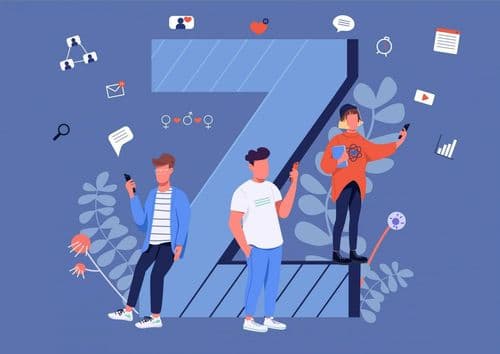The new year is almost here, which means every savvy marketer has their eyes peeled for new trends and strategies that will undoubtedly move the needle in 2024.
Crank up your favorite playlist and get dialed in, because our tenured, in-tune experts have assembled the hottest marketing trends to inform your strategy and help you smash your goals in 2024 and beyond.
Spoiler alert: we’ve crowned 2024 the year of personalization, aka 366 days (leap year!) of marketers being challenged to deliver customized brand experiences at every stage of the buyer’s journey.
First-party data collection: a must-have, not a nice-to-have

Recent updates to data protection regulations and rulings are good reminders that best practices for third-party data collection have drastically changed. Right meow, marketers are leveraging aggressive first-party collection strategies that engage and incentivize user inputs.
Think quizzes, surveys, webinars, and loyalty programs. Whatever you choose, keep this top of mind: these strategies need to resonate with your target personas and provide enough value to persuade them to share their valuable data.
Webinars are a fantastic way to introduce your team, share your expertise, and provide enough value to collect that coveted data. We’re also living in a virtual events renaissance, with organizers ranking increased registration, greater ROI, and improved attendee engagement as top benefits of virtual events compared to in-person events.
Email marketing: this throwback is making a comeback

As an integrated marketing agency, we love bringing classic tactics into the mix. In the present day, email marketing is still incredibly powerful. Constant Contact reports that brands make $36 for every U.S. dollar they spent on email marketing. And, when you blend this consistently killer tactic with the shifting data collection environment we mentioned above, you have the power to deliver dynamic, automated email campaigns.
Leverage your hard-won first-party data to develop hyper-targeted messaging. Create meaningful points of connection to move your audience through the sales funnel and convert new contacts into long-term customers and, with ample time and brainpower, into hardcore brand aficionados.
For a real-world example, Element built an email automation flow for a coffee brand, targeting customers who had ordered in the past, but hadn’t ordered in more recent months. Through a series of offers and personalized messages encouraging the customers to return, users were effectively enticed to buy. The coffee client’s email automation generated $25k in revenue from 400+ orders, and the automation continues to run with solid results.
YouTube ads: turn up web traffic as users tune in

When we wrote this article, YouTube ads had generated $14B in revenue so far in 2023. Another stat that might shiver your timbers: video ads displayed before a video achieve an average 30% view rate, which can do wonders for impressions and click-throughs. There’s even more good news—YouTube is continuously rolling out new digital ad placement types, so you have endless possibilities to explore while developing impactful messaging strategies.
Here’s a snapshot of results we won via YouTube advertising for a food client, proving just how powerful ads run on this channel can be in serving up website traffic and brand awareness.
AI: personalization’s new bestie

Marketers (like those on our AI taskforce) are at the forefront of using AI for content creation, SEO, media buying, and more, and that’s something you’ll see across the industry in 2024. 64% of marketers say AI is either very important or critically important to their marketing success over the next 12 months. And consumers expect a high degree of personalization from brands—63% of them, to be exact.
With the latest and best AI and machine-learning tools, you can specialize and scale content creation using powerful, real-time data. Companies like Amazon, Netflix, and Spotify use their customer data to provide personalized content recommendations that perform well—for instance, over two thirds of the shows watched on Netflix are based on AI-tailored recommendations.
To improve customer experience even more, combine user preferences data with usage insights to offer content that resonates, all within an interface that is intuitive and easy to use. For instance, from AI, you might know that most users are interested in the history behind your brand, and likewise you may have learned that your website users are only scrolling 20% through your pages. In that case, it would be sensible to put brand content front and center, aka above the fold.
SEO optimization for voice search: rankings on the rise

Consumers are talking to their devices more than ever, with more than 50% of adults using voice search daily. Likewise, search queries are becoming more unique and natural, aligning with the way humans speak (vs. how they type). Search engine algorithms are evolving alongside voice search, advancing to rank websites aligned with voice search intent.
To ensure your website ranks higher than your competition, it’s essential to optimize your webpages for long-tail search phrases, guided by voice search keywords and trends. These new spoken keywords will also help you spot bigger picture topics and trends that can influence creative direction for integrated campaigns—and better give users the bespoke information they’re looking for.
To illustrate the trend, consider an example. A client of ours wanted to gain traction for highly competitive keywords like “goat cheese,” but faced big competition from well-known sites like Real Simple and Wikipedia. We found a new avenue to achieve higher rankings through voice search. More specifically, we focused on selecting long-tail keywords, uncovering voice search opportunities, posting new and trending recipes and blog posts, and answering common goat cheese questions. We covered all the bases, too, by optimizing copy and meta data on relevant webpages. The results? Pretty tasty. Organic search traffic to the site nearly doubled in less than two years. #SEOGOAT
Did we whet your appetite for actionable insights? Worry not—there’s more where these came from.
This is only half of our must-see marketing trends for 2024, and I’d love to share the full list with you. Drop me a line at [email protected] and I’ll send you the guide ASAP.






